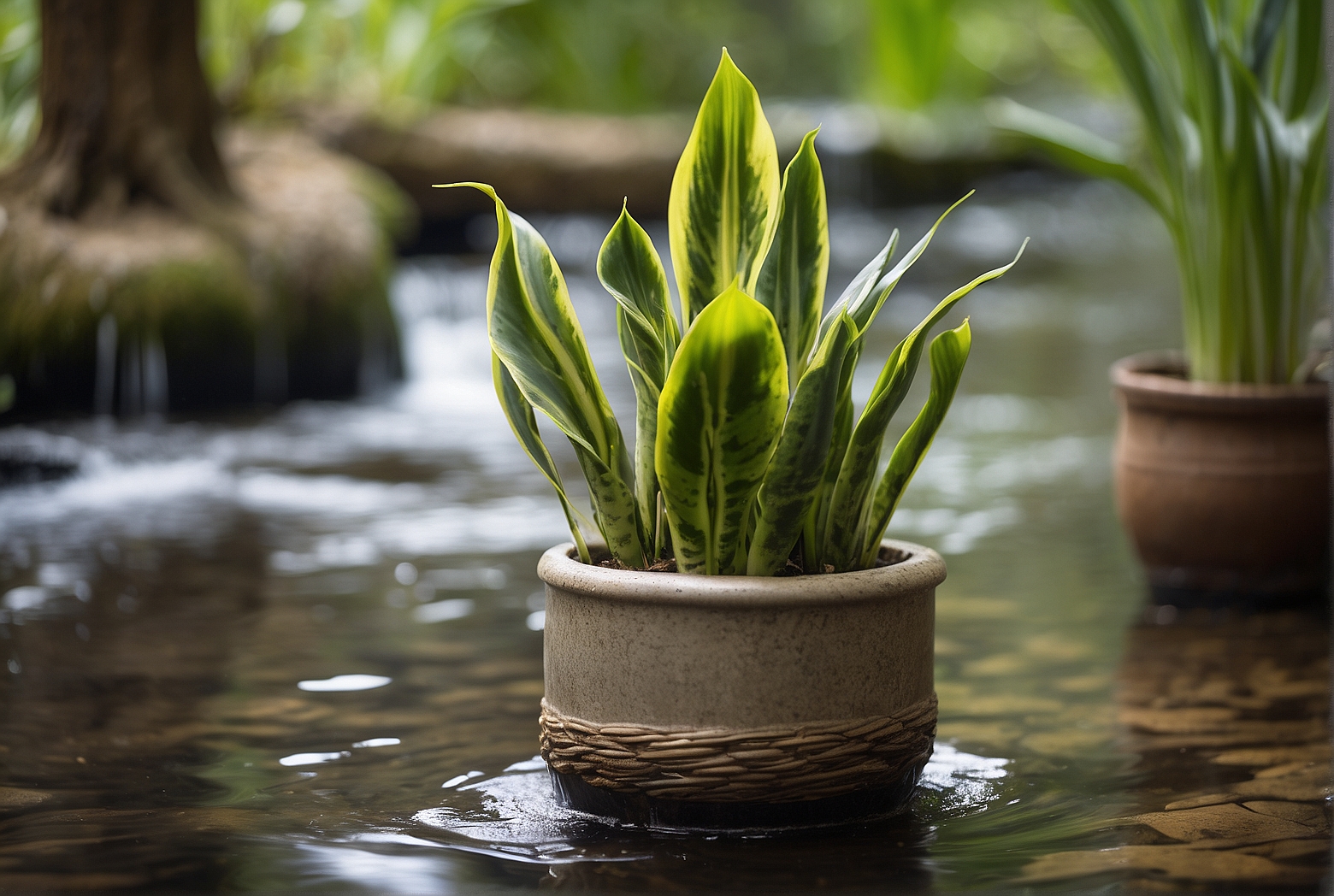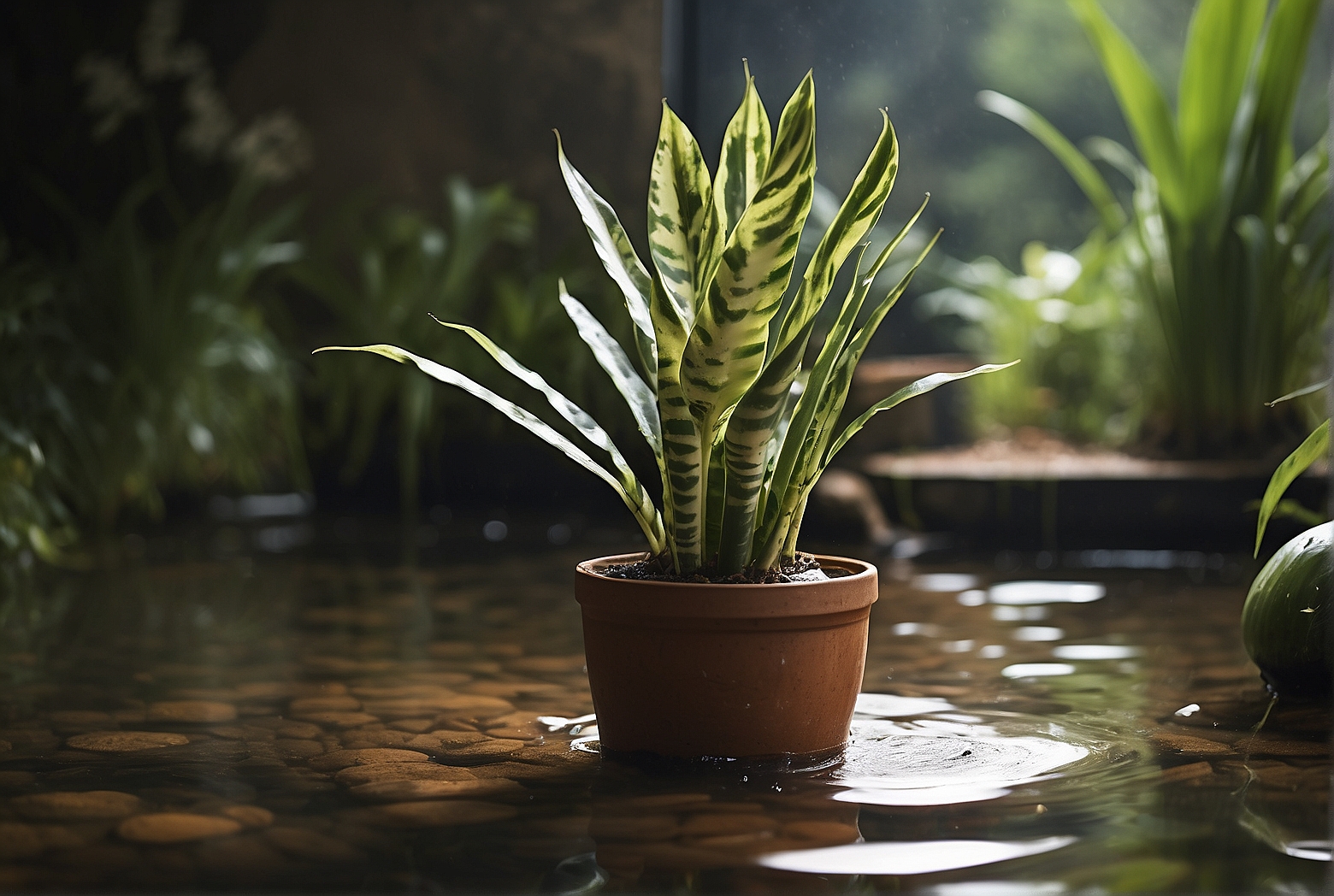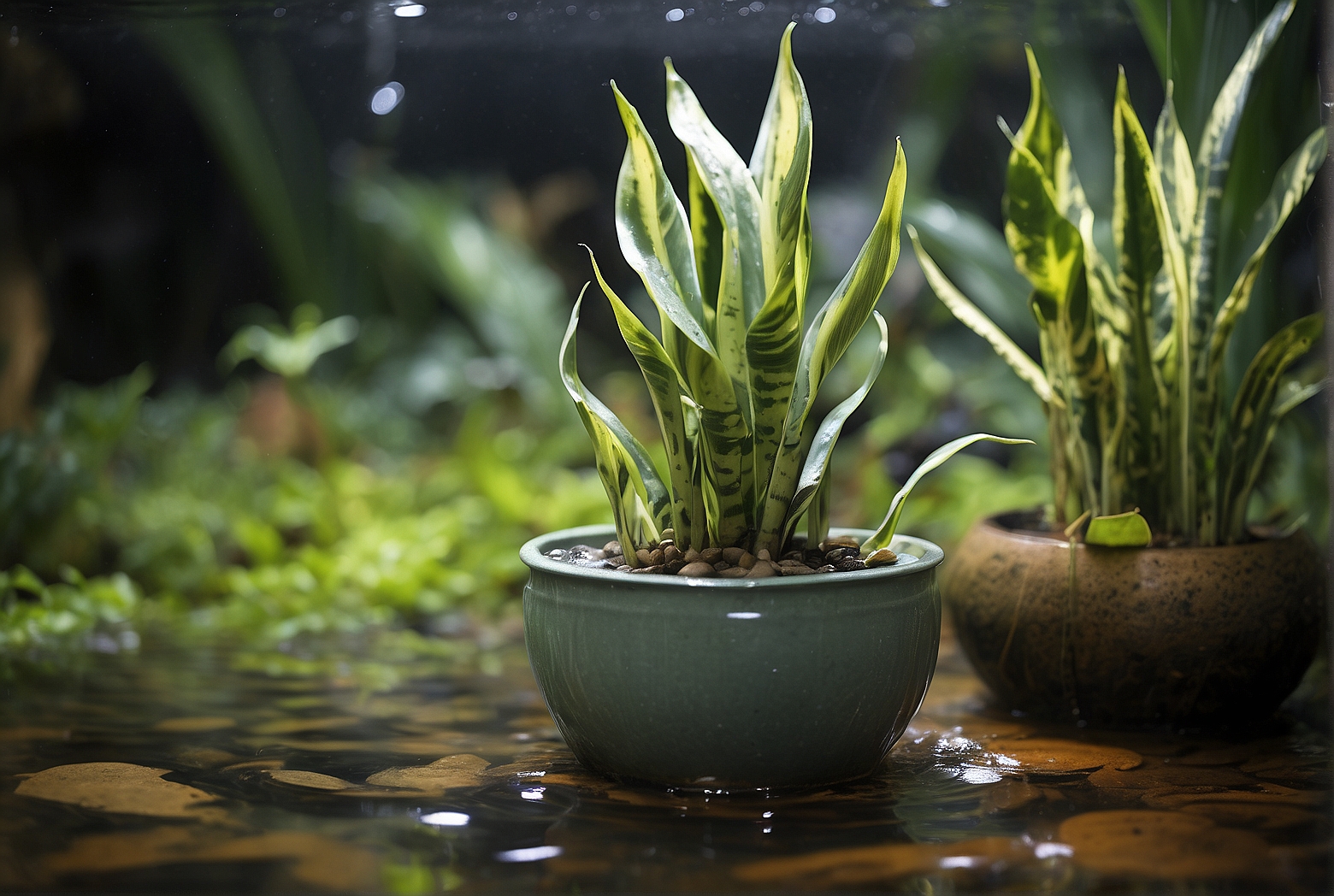Last Updated on April 18, 2024 by Tony Manhart
Snake plants, also known as Sansevieria, are beloved houseplants known for their resilience and striking appearance. These charismatic plants have captivated many indoor gardeners with their air-purifying qualities and low-maintenance nature. While they are typically grown in well-draining soil, the question arises: Can snake plants thrive in water? This article aims to explore the possibilities of growing snake plants solely in water, providing insights into their adaptability and potential benefits. Whether you’re a curious plant enthusiast or a novice gardener looking to add some greenery to your home, read on to uncover the secrets of cultivating these fascinating plants in water.
Introduction
Welcome to our comprehensive guide on growing snake plants in water! Snake plants, also known as Sansevieria, are popular houseplants known for their unique appearance and low maintenance requirements. In this article, we will explore the various aspects of snake plant care, with a particular focus on their water requirements and the benefits of growing them in water. Whether you’re a seasoned plant enthusiast or a beginner looking to add a touch of green to your living space, we’ve got you covered.
Overview of Snake Plants
Description of Snake Plants
Snake plants are tropical plants that belong to the Asparagaceae family. They are characterized by their long and slender leaves, which grow upright and resemble the shape of a snake, hence their name. These plants come in a variety of cultivars, ranging from ones with dark green leaves to those with variegated patterns of white or yellow. Some snake plants can also produce fragrant flowers, although this is rare in indoor settings.
Snake Plants as Popular Houseplants
Snake plants have gained popularity as houseplants due to their ability to thrive in a wide range of growing conditions. They can tolerate low light levels, making them suitable for areas that receive minimal sunlight. Additionally, snake plants are known for their air-purifying properties, as they remove toxins such as formaldehyde from the air. Their striking visual appeal and ease of care also contribute to their popularity among plant enthusiasts.

Benefits of Having Snake Plants
Having snake plants in your home offers several benefits beyond their aesthetic appeal. These plants have been shown to improve indoor air quality by absorbing toxins and releasing oxygen. Snake plants also release moisture vapor into the air, increasing humidity levels and benefiting respiratory health. Furthermore, their low maintenance requirements make them an ideal choice for busy individuals or those new to plant care.
Common Types of Snake Plants
Snake plants come in various types, each with its own unique appearance. Some popular varieties include:
- Sansevieria trifasciata: Also known as the “mother-in-law’s tongue,” this variety has dark green leaves with gray-green horizontal stripes.
- Sansevieria laurentii: Commonly referred to as the “variegated snake plant,” it features long, sword-shaped leaves with yellow edges.
- Sansevieria cylindrica: This variety has cylindrical leaves that grow upright, giving it a distinctive look.
- Sansevieria moonshine: With its silvery-green leaves, this cultivar adds a touch of elegance to any space.
- Sansevieria black gold: As the name suggests, this variety has dark green leaves with golden-yellow edges, creating a striking contrast.
Water Requirements for Snake Plants
Natural Habitat of Snake Plants
To understand the water requirements of snake plants, it’s essential to consider their natural habitat. Snake plants originate from arid regions of West Africa, where they have adapted to survive in dry and sandy soils. In their native environment, these plants can endure long periods of drought and are well-suited to low water availability.
Watering Needs of Snake Plants
Snake plants are highly drought-tolerant and prefer to be slightly underwatered rather than overwatered. A general rule of thumb is to allow the soil to dry out between waterings. When watering, it is crucial to ensure that the pot has proper drainage to prevent waterlogging and root rot.

Effects of Overwatering
Overwatering can be detrimental to snake plants, as they are susceptible to root rot. If the soil becomes excessively saturated, the roots are deprived of oxygen and may start to decay. Signs of overwatering include yellowing leaves, mushy roots, and a foul odor emanating from the soil.
How Snake Plants Absorb Water
Snake plants have a unique way of absorbing water through their roots. In addition to absorbing water from the soil, they can also derive moisture from the air through their leaves. This adaptation allows them to survive in both dry and humid environments, making them versatile plants for different growing conditions.
Water Propagation of Snake Plants
What is Water Propagation?
Water propagation is a method of plant propagation that involves rooting plant cuttings in water instead of soil. It is a popular technique used to propagate various plants, including snake plants. Water propagation allows you to grow new plants from cuttings, making it an excellent way to expand your collection or share plants with others.
Advantages of Water Propagation
Water propagation offers several advantages over traditional soil propagation methods. Firstly, it allows you to monitor root development and ensure that the cutting is growing healthy roots before transplanting it into soil. Secondly, water propagation provides a visually appealing way to display your growing plant cuttings, adding a touch of green to your living space. Finally, water propagation can be a fun and educational activity that allows you to witness the growth process firsthand.
Step-by-Step Guide for Water Propagation
- Select a healthy snake plant leaf or leaf section that is at least 2-3 inches long.
- Fill a container with clean water, ensuring that the bottom portion of the cutting will be submerged.
- Place the cutting in the water, making sure that the bottom end is immersed in the water while the top remains above the surface.
- Position the container in a location with bright, indirect light.
- Change the water every 1-2 weeks to prevent the growth of algae and keep it fresh.
- Monitor the cutting for the emergence of roots, which typically takes 4-8 weeks.
- Once the roots are well-developed, you can transplant the cutting into a pot with well-draining soil.
Ideal Conditions for Successful Water Propagation
To ensure successful water propagation of snake plants, it is important to create the ideal conditions for root development. Here are some key factors to consider:
-
Lighting: Place the container in a location that receives bright, indirect light. Avoid direct sunlight, as it can cause leaf burn.
-
Water Quality: Use clean, filtered water or allow tap water to sit overnight to allow chlorine to evaporate. This helps to prevent any harmful chemicals from affecting the cutting.
-
Temperature: Maintain a temperature range of 70-90°F (21-32°C) for optimal root growth. Avoid exposing the cutting to extreme temperatures or drafts.
-
Container Choice: Choose a clear glass or plastic container that allows you to monitor root development. Ensure that the container is clean and free from any residue or contaminants.
Growing Snake Plants in Water
Can Snake Plants Thrive in Water?
Yes, snake plants can thrive in water, making them an excellent choice for water-based gardening. Growing snake plants in water is an alternative method to traditional soil-based gardening, offering unique benefits and a visually appealing display.
Benefits of Growing Snake Plants in Water
Growing snake plants in water provides several advantages for both the plants and the gardener. Firstly, it eliminates the need for soil, reducing the risk of pests and soil-borne diseases. Secondly, water-based gardening allows for easier nutrient absorption, as the plant can directly uptake nutrients dissolved in the water. Furthermore, growing snake plants in water offers a unique and eye-catching display, with the chance to showcase the plant’s root system.
Choosing a Suitable Container
When selecting a container for growing snake plants in water, you have a few options to consider. Glass vases or jars are popular choices, as they allow you to easily observe the roots and add an aesthetic appeal to your indoor space. Alternatively, you can also use plastic containers, ensuring they are clean and free from any residues or toxins. Whichever container you choose, make sure it has adequate depth and stability to support the plant.
Preparation of Water for Snake Plants
To provide the best growing conditions for snake plants, it is important to prepare the water properly. Here are a few steps to follow:
-
Fill a container with clean, chlorine-free water. If using tap water, let it sit overnight to allow any chlorine or other chemicals to dissipate.
-
Adjust the pH of the water, if necessary. Snake plants thrive in slightly acidic to neutral pH conditions, ideally between 6.0 and 7.0. Test the pH of the water using a pH testing kit and adjust it using pH up or down products, if needed.
-
Consider adding a diluted liquid fertilizer to the water to provide essential nutrients for the plants. Choose a balanced fertilizer specifically formulated for indoor plants and follow the recommended dosage instructions.
Placing the Snake Plant in Water
Once you have prepared the water and chosen a suitable container, it’s time to place the snake plant in water. Follow these steps:
- Gently remove the snake plant from its current pot and shake off any excess soil.
- Carefully lower the root system of the plant into the water, ensuring that the roots are fully submerged.
- Maintain the water level, ensuring that it covers the roots without covering the leaves.
- Position the container in a location that receives bright, indirect light. Avoid placing it in direct sunlight, as it can cause leaf burn.
Caring for Snake Plants in Water
Caring for snake plants grown in water is relatively straightforward. Here are some essential tips to keep in mind:
-
Light: Snake plants grown in water still require bright, indirect light to photosynthesize. Place the container in a location that receives ample sunlight or use artificial grow lights if natural light is limited.
-
Water Level: Monitor the water level regularly and ensure that it covers the roots at all times. As the plant grows, you may need to increase the water level to accommodate the increased root growth.
-
Water Quality: Maintain clean water by changing it every 1-2 weeks. This helps prevent the growth of algae and ensures the plant has access to fresh nutrients.
-
Nutrient Supplementation: Although snake plants can derive nutrients from the water alone, periodically supplementing with a diluted liquid fertilizer can promote healthy growth. Follow the recommended dosage instructions on the fertilizer packaging.
Maintenance Tips for Water-Grown Snake Plants
Ensuring Sufficient Light
To ensure the health and vitality of water-grown snake plants, adequate lighting is crucial. Place the container in a location that receives bright, indirect light for at least 6-8 hours a day. If natural light is insufficient, consider using artificial grow lights to provide the necessary light intensity.
Watering Considerations
Maintaining the proper water level is essential for the well-being of water-grown snake plants. Check the water level regularly and ensure that it covers the roots without submerging the leaves. Avoid letting the water level drop too low, as this can lead to dehydration and stress for the plant.
Fertilizing Water-Grown Snake Plants
While snake plants in water can derive nutrients from the dissolved minerals in the water, they can also benefit from periodic fertilization. Use a diluted liquid fertilizer specifically formulated for indoor plants and follow the recommended dosage instructions. Apply the fertilizer every 1-3 months, depending on the strength of the solution and the growth rate of the plant.
Pruning and Cleaning the Plants
Regular pruning helps maintain the overall health and appearance of water-grown snake plants. Remove any dead or yellowing leaves by cutting them at the base with clean pruning shears or scissors. Additionally, clean the container and change the water regularly to prevent the buildup of algae or bacteria that can affect the plant’s health.
Monitoring for Pests and Diseases
While water-grown snake plants are generally less prone to pests and diseases than their soil-grown counterparts, it is still important to monitor them for any signs of infestation or damage. Inspect the leaves and roots regularly for pests such as mealybugs or spider mites. If necessary, treat the plant with an appropriate organic or chemical solution to eliminate the pests.
Common Issues with Water-Grown Snake Plants
Root Rot and Overwatering
Overwatering is a common issue that can lead to root rot in snake plants. To prevent this, ensure that the container has proper drainage and avoid excessive watering. If you notice root rot, remove the affected roots, allow the plant to dry out, and adjust the watering regime accordingly.
Algae Growth in Water
Algae growth is another common problem in water-grown snake plants. To control algae, change the water every 1-2 weeks to prevent stagnation and provide fresh nutrients. Additionally, you can place the container in a location with reduced light exposure or use algae inhibitors available in gardening stores.
Nutrient Deficiencies
While snake plants can derive nutrients from the water alone, nutrient deficiencies may occur over time. Look out for yellowing or browning of leaves, stunted growth, or overall decline in the plant’s health, as these may be signs of nutrient deficiencies. To address this, consider supplementing with a diluted liquid fertilizer to provide the necessary nutrients.
Lack of Aeration in Water
The lack of oxygen in the water can negatively impact the roots of snake plants. It is important to prevent stagnant water and provide adequate aeration. You can achieve this by using an air stone or aquarium pump to circulate the water and enhance oxygenation.
Transitioning Snake Plants from Water to Soil
Reasons to Transition from Water to Soil
While snake plants can thrive in water, there are several reasons why you may want to transition them to soil. Firstly, soil provides a more stable and nutrient-rich environment, promoting increased growth and overall plant health. Secondly, soil acts as a buffer, holding water and nutrients more effectively than water alone. Additionally, transitioning to soil allows for more flexibility in terms of plant placement and arrangement.
Step-by-Step Guide for Transitioning
If you decide to transition your water-grown snake plant to soil, follow these steps:
- Prepare a well-draining potting mix suitable for snake plants. A mix containing components like peat moss, perlite, and vermiculite works well.
- Gently remove the snake plant from the water, taking care not to damage the roots.
- Shake off any excess water and allow the roots to dry slightly for a few hours.
- Plant the snake plant in the prepared potting mix, ensuring that the roots are adequately covered and supported.
- Water the plant thoroughly after transplanting and place it in a location that receives bright, indirect light.
- Monitor the plant closely for the first few weeks, providing proper care and adjusting watering as needed.
Acclimating the Snake Plant to Soil Conditions
During the transition from water to soil, it is important to acclimate the snake plant gradually to its new growing environment. This helps the plant adjust to the differences in moisture levels and allows the root system to adapt. Begin by initially watering the newly transplanted snake plant lightly, gradually increasing the frequency and amount of water over time. Monitor the plant closely and adjust the watering regime based on its response.
Conclusion
Snake plants are versatile and hardy plants that can thrive in various conditions, including water-based gardening. Whether you choose to grow them in water or transition them to soil, these plants offer numerous benefits, including air purification, low maintenance requirements, and unique visual appeal. By following the guidelines outlined in this comprehensive article, you’ll be well-equipped to care for your snake plant and enjoy its beauty and health benefits for years to come.
Resources
Additional Reading Materials
- “The Snake Plant Care Manual” by Charlotte Brooks
- “Plants for Clean Air: A Guide to the Best Air-Purifying Indoor Plants” by James Collins
- “The Art of Water Propagation: A Comprehensive Guide to Growing Plants in Water” by Emily Greenleaf
Recommended Products for Water-Grown Snake Plants
- Glass Vase Set with Drainage Hole
- Liquid Plant Fertilizer for Indoor Plants
- pH Testing Kit for Water
- Aquarium Air Stone and Pump Kit
Tony Manhart is a passionate gardener who has been tending to gardens for over 20 years. He takes pride in creating beautiful outdoor spaces with plants, trees, and shrubs that can thrive in any environment. He loves to share his knowledge with others and has taught classes on gardening basics and advanced techniques. He is committed to sustainability, using natural and organic methods to create and maintain gardens. He also works with local organizations to create green spaces for communities. When he’s not gardening, Tony enjoys hiking, reading, and spending time with his family.


